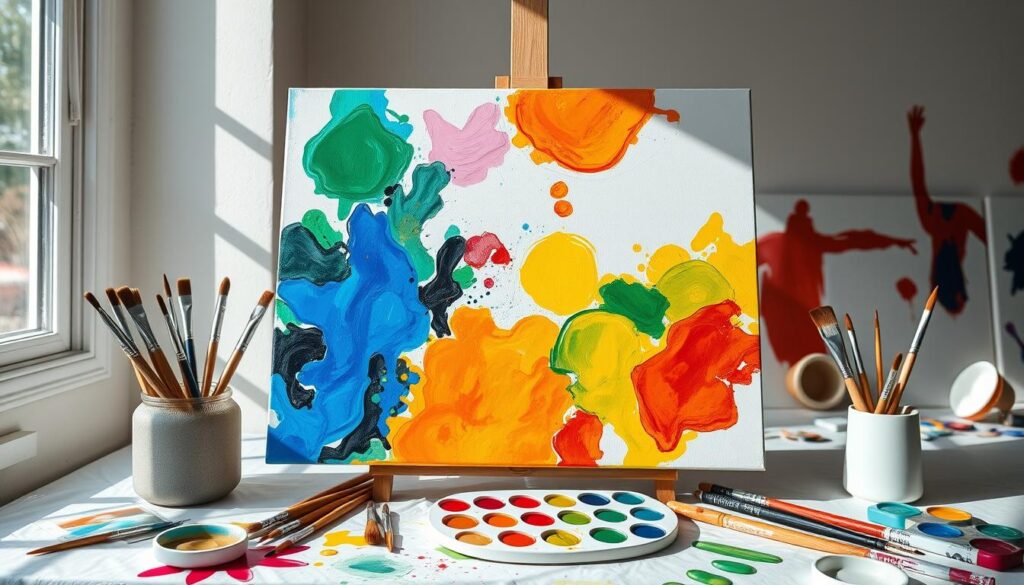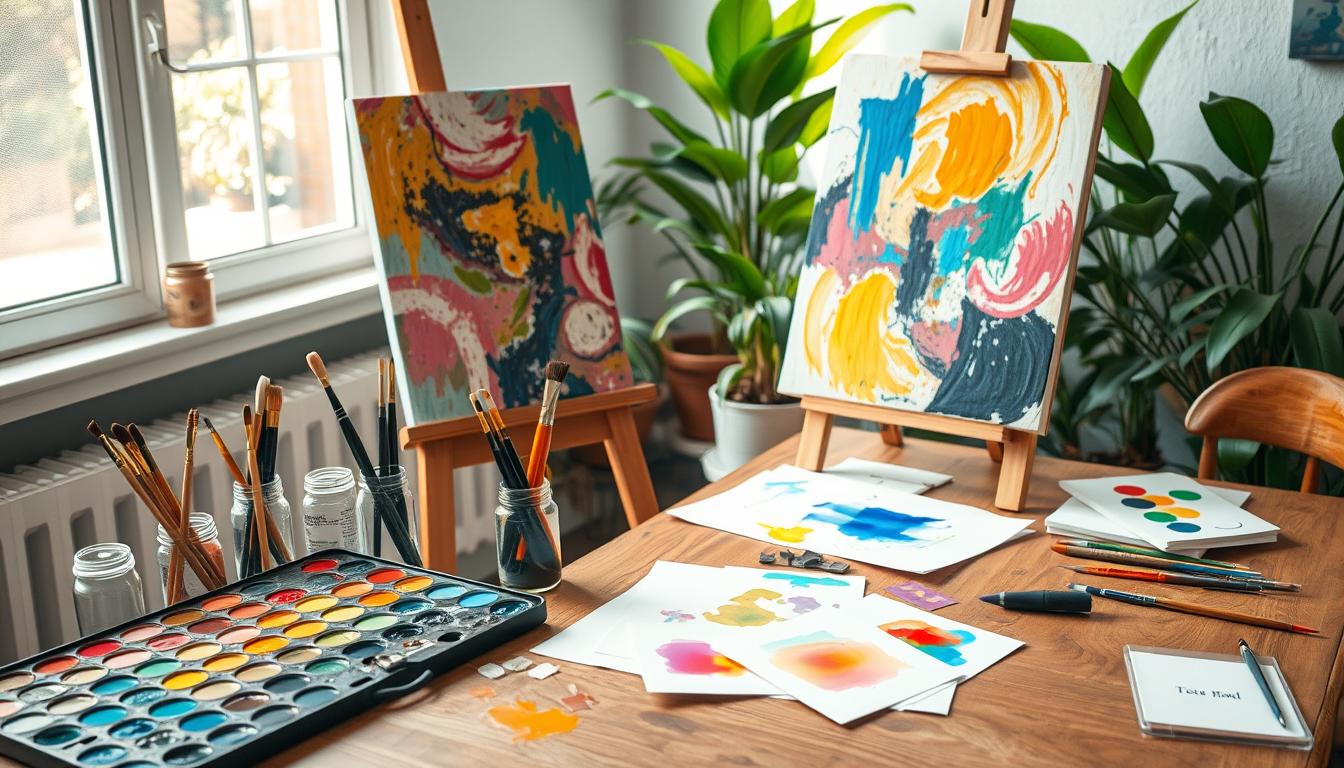This post contains affiliate links.
As an artist, I remember my first brush stroke on a blank canvas. I felt both excited and scared. Composition was the key to unlocking my acrylic paintings’ true potential. Let’s explore the basics of captivating acrylic painting composition together.
Key Takeaways
- Understand the fundamental principles of artistic composition, including balance, focal points, and negative space.
- Explore the versatility of the Rule of Thirds and the Golden Ratio in creating visually striking acrylic paintings.
- Discover techniques for developing unique composition styles, from central focus to low horizon lines.
- Learn the importance of sketching and planning your composition before diving into the painting process.
- Uncover the secrets of layering and color mixing to enhance the visual impact of your acrylic paintings.
Whether you’re new to acrylic painting or looking to improve, this guide has you covered. It will give you the tools and techniques to make your compositions stand out. Get ready to unlock your acrylic paintings’ full potential and share your artistic vision with the world.
Introduction to Acrylic Painting
Acrylic painting is a versatile and easy-to-start medium. It’s loved by artists of all levels. Unlike oil paints, acrylic paints dry fast, letting artists work quickly. They’re water-based, making cleanup easy and can be used on many surfaces.
Differences Between Acrylic and Oil Painting
Acrylic and oil paints both create vibrant art, but they’re different. Acrylic paint uses a acrylic polymer binder, while oil paint uses oils. This means acrylic paints dry in 20-30 minutes, much faster than oil paints.
Advantages of Acrylics for Beginners
Acrylic paints are great for new artists. They’re cheaper than oil paints and clean up with water. This makes them less messy and easier to work with. Plus, they have a lower odor, perfect for indoor use or shared spaces.
“Acrylic paint is a great choice for beginner painters as it is more affordable, dries quickly, and can be cleaned up with water.”
Essential Acrylic Painting Supplies
Starting your acrylic painting journey means getting the right supplies. You’ll need acrylic paint colors, brushes, and surfaces to paint on. Each item is key to bringing your art to life.
Acrylic Paint Colors and Brands
Choosing acrylic paints involves a student-grade vs artist-quality decision. Student-grade paints are cheaper but have more additives. Artist-quality paints have more pigment for brighter colors. Top brands like Golden, Liquitex, and Winsor & Newton are great choices.
For mixing, keep titanium white, mars or ivory black, and colors like cadmium red and yellow handy. Also, phthalo blue, green, and dioxazine purple are essential.
Brushes, Palettes, and Painting Surfaces
You’ll need various brushes for different effects. A palette is for mixing colors. You can paint on canvas, paper, or panels.
Don’t forget rags, paper towels, and two water containers. One for clean water and one for dirty.
| Acrylic Painting Supplies | Student-Grade | Artist-Quality |
|---|---|---|
| Acrylic Paint Colors | More affordable, with more additives and extenders | Higher pigment load, resulting in brighter, more vibrant colors |
| Brushes | Affordable, but may not hold their shape as well | Higher quality, with better bristle retention and control |
| Painting Surfaces | Less expensive, but may not be as durable or archival | Artist-grade canvas, paper, or panels for professional-quality results |
Investing in quality acrylic painting tools will help you create amazing paintings. Your art will truly show your vision.

Setting Up Your Workspace
Setting up your acrylic painting space is key. You need a dedicated area that supports your creativity. Acrylics dry fast, so you must prepare to keep your space clean and your art safe.
Protecting Your Work Area
Choose a small table or area in your home for painting. Use a plastic drop cloth to cover the table and protect it from spills. Then, place a cotton drop cloth on top for a soft, absorbent surface.
To guard your floor, put a drop cloth or plastic sheeting under your chair or easel. This prevents drips or splatters from staining your floor.
| Workspace Protection | Purpose |
|---|---|
| Plastic Drop Cloth | Protects the table surface from paint spills |
| Cotton Drop Cloth | Provides a soft, absorbent surface for painting |
| Floor Protection | Prevents paint from staining the floor |
By protecting your workspace, you create a clean, organized space. This lets you focus on your art without worrying about messes.
Preparing Your Canvas or Surface
Before starting your acrylic painting, make sure your canvas or surface is ready. This step is key for a great painting. It lets your colors stand out and your brushstrokes be smooth.
Applying Gesso Primer
If your canvas, paper, or panel isn’t pre-gessoed, start with a gesso priming layer. Gesso is a white, acrylic-based medium that makes your surface smooth and ready for paint. Use a large, flat brush for two coats of gesso. Wait for the first coat to dry before adding the second, going in a different direction.
Even if your canvas is already pre-gessoed, adding more gesso can improve it. This extra layer helps your paint stick better and makes your painting last longer. It’s a small step that can make a big difference.
“Priming with gesso reduces the absorbency of the canvas, aiding in better paint adhesion and longevity of the artwork.”
Let the gesso dry for at least 24 hours before painting. This ensures your painting has a solid base.
Choosing a Composition Style
When starting an acrylic painting, picking a composition style is key. It greatly affects the artwork’s visual impact and story. Two main techniques are central composition and low horizon line composition.
Central Composition
A central composition puts the main focal point in the painting’s center. This method draws the viewer’s eye to the key element. It creates balance and highlights a specific object or figure.
Low Horizon Line Composition
A low horizon line composition, or “big sky” style, places the horizon low on the canvas. It’s perfect for landscape paintings. This style focuses on the sky, adding grandeur and drama to the scene.
Choosing your acrylic painting composition depends on the story and mood you aim for. Try both central and low horizon line compositions. See which fits your artistic vision and subject best.

Sketching Your acrylic painting composition basics
Starting your acrylic painting journey? The sketching composition is key. It sets the stage for your masterpiece. You can use a reference image or dive into abstract vs representational art. Sketching lets you plan and try out painting planning ideas before you start painting.
Start by sketching your composition with paint or charcoal. If you have a reference image, this is easier. But for abstract art, you’ll need to be more flexible. Let your painting guide you as you go.
The sketching phase is all about exploring and finding balance. It’s not about making it perfect. Try different things, play with elements, and let your creativity lead. This process helps you understand your vision better and prepares you for the next steps in your painting journey.
“The act of sketching is a powerful tool for artists to explore, refine, and ultimately bring their creative visions to life on the canvas.”
Layering and Color Mixing Techniques
Acrylic painting is all about layering. You build up textures and depth by adding paint in layers. Knowing the difference between opaque and translucent acrylic paints is key to getting the look you want.
Opaque vs. Translucent Paints
Opaque paints are thick and cover everything underneath. Translucent paints let some of the old layers show. Mixing these paints can add depth and light to your art. Try different paint thicknesses and acrylic layering methods to see what works best.
Wet-on-Wet and Dry Brushing
Wet-on-wet and dry brushing are two favorite techniques. Wet-on-wet means painting wet paint on wet canvas, blending colors as you go. Dry brushing uses a bit of paint on a dry brush for texture and to show what’s underneath. Learning these color mixing and wet-on-wet methods opens up new creative paths in your acrylic art.
“Acrylic painting is all about exploring the various acrylic techniques and finding what works best for your unique artistic style.”
Success in acrylic layering and color mixing comes from trying new things, being patient, and enjoying the process. Dive in, have fun, and let your creativity flow!
| Technique | Description | Advantages |
|---|---|---|
| Wet-on-Wet | Applying wet paint onto a wet surface, allowing for blending and color mixing directly on the canvas. | Spontaneous, fluid effects; creates a sense of movement and depth. |
| Dry Brushing | Using a small amount of paint on a dry brush to create textural effects and reveal underlying layers. | Adds depth and interest; can be used to create expressive, energetic brushstrokes. |
Developing Focal Points and Contrast
Making a great acrylic painting is more than just putting paint on canvas. It’s about creating focal points and contrast. These elements help guide the viewer’s eye and make the artwork interesting.
When you add layers to your painting, pick a clear focal point to draw the viewer in. This could be a main subject, a bright color, or a contrast area. It’s important to balance contrast in value, color, and brushstrokes to add interest and depth.
Many beginners, 79%, feel their art is incomplete because of composition problems. By focusing on focal points and contrast, you can avoid this and make art that grabs people’s attention.
To make your focal points stand out, try these techniques:
- Use negative space to isolate your subject
- Try high-contrast colors
- Play with different brushstrokes and line thicknesses
- Use the Golden Ratio to place key elements
Good composition means all parts work together, with the focal point leading the viewer’s eye. By mastering focal points and contrast, your acrylic paintings will be more impactful and emotionally powerful.
“Composition is the strongest way to point your lens, to express your intentions with your camera, to make a statement.”
– Greg Heisler, Photographer
As you get better at acrylic painting, remember to focus on focal points and contrast. Using these in your art will make it captivating and inspiring, leaving a strong impression on your audience.
Using Acrylic Mediums for Effects
Acrylic painting lets artists create unique effects. By using different acrylic mediums, you can change the paint’s texture, sheen, and flow. This helps you express your artistic vision.
Acrylic mediums are special products that change acrylic paint’s properties. They can make the paint more transparent or add a matte or glossy finish. Trying out different mediums can help you find your unique style.
- Acrylic Gels and Pastes: These mediums help build texture and create thick, raised areas in your paintings. They add depth and dimension.
- Acrylic Mediums: Mediums like gloss, matte, and fluid can change the paint’s sheen and flow. This lets you achieve various finishes.
- Acrylic Retarders and Extenders: These mediums slow down the paint’s drying time. This gives you more time to blend and work with the paint.
Using acrylic mediums opens up a world of creative possibilities. Embrace their versatility and let your imagination explore the endless potential of acrylic painting.
“Acrylic mediums are the secret to unlocking the true potential of acrylics. They allow you to manipulate the paint in ways that are simply not possible with the paint alone.”
Evaluating When a Painting is Complete
Deciding when to stop working on a painting is tough but key. Artists often want to perfect every detail. This can lead to overworking and losing the painting’s true essence. With practice and knowing the signs, we can trust our instincts and find the right balance.
Getting Feedback and Fresh Perspectives
Getting feedback from others is a great way to check if a painting is done. Talking to fellow artists, art lovers, or even those new to can offer valuable insights. Their views can help us see what we’ve missed or overlooked, guiding us in making the final touches.
Also, looking at the painting from different angles can show what needs more work. Looking at it upside down or from far away can reveal balance and composition issues. This active observation is key to knowing when a painting is complete.
“The true sign that a painting is finished is a sudden sense of awe or satisfaction, a feeling that the work has achieved a harmonious balance of contrast, focal points, and emotional resonance.”
By accepting feedback, being critical, and trusting our gut, we can figure out when a painting is ready. This balance between skill and creativity makes the journey of painting completion rewarding.
In conclusion, evaluating a painting’s completion is unique to each artist. It requires understanding our goals, seeking outside views, and making tough choices. By embracing this, we can create art that fulfills us and connects with others.
Conclusion
Acrylic painting is easy and fun for both new and seasoned artists. It teaches you the basics, like setting up your space and mixing colors. This lets you explore your creativity and start a fulfilling artistic path.
Don’t be afraid to try new things and enjoy the process. The more you acrylic painting tips, the better you’ll get. Acrylics dry fast, so you can play with colors, textures, and finishes. Every stroke brings your ideas to life and helps you grow as an artist.
Acrylic painting is great for anyone looking to express themselves. It’s easy to use and lets you reach your artistic dreams. So, let your creativity shine, use acrylics’ special qualities, and start your artistic adventure with excitement and dedication.
FAQ
What are the differences between acrylic and oil painting?
Why is acrylic painting a good choice for beginners?
What essential acrylic paint colors should I have on hand?
What supplies do I need to set up an acrylic painting workspace?
How do I prepare my canvas or painting surface?
What are some popular composition styles for acrylic paintings?
How do I plan the composition of my acrylic painting?
What acrylic painting techniques should I try?
How do I develop a focal point in my acrylic painting?
How can I use acrylic mediums to create different effects?
How do I know when my acrylic painting is finished?
This post contains affiliate links.

